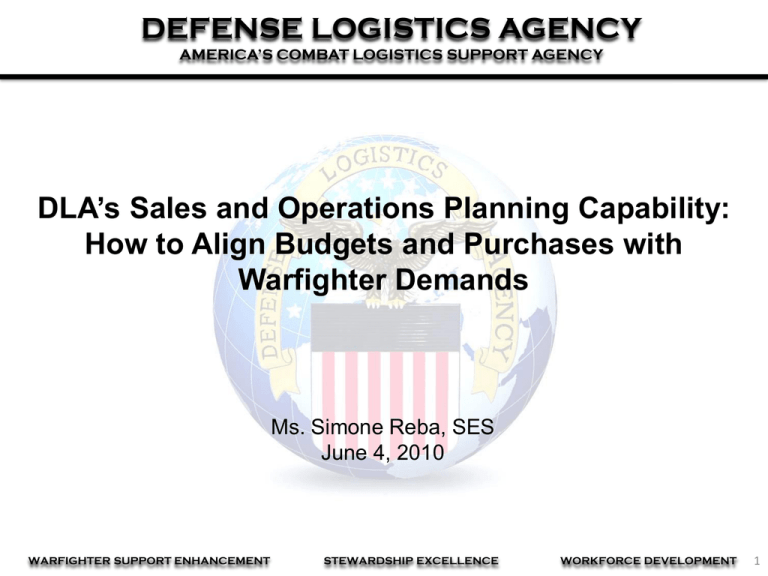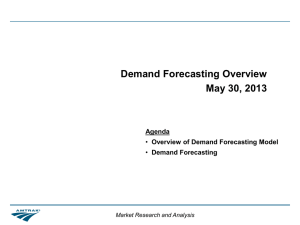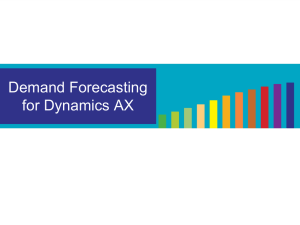DLA`s Sales and Operations Planning Capability
advertisement

DEFENSE LOGISTICS AGENCY AMERICA’S COMBAT LOGISTICS SUPPORT AGENCY DLA’s Sales and Operations Planning Capability: How to Align Budgets and Purchases with Warfighter Demands Ms. Simone Reba, SES June 4, 2010 WARFIGHTER SUPPORT ENHANCEMENT STEWARDSHIP EXCELLENCE WORKFORCE DEVELOPMENT 1 Workshop Goals • Introduce Sales & Operations Planning (S&OP) • Explain how DLA uses S&OP to drive improved customer readiness • Discuss how customer collaboration and DLA’s S&OP process can help all of us better serve the Warfighter 2 Scenario Funding for this FY has been cut by 10% from last year numbers while Sales are forecasted to remain flat * • FY ‘09 – Funding was $500M – Sales were $500M • FY ‘10 – Funding is $450M – Forecasted Sales for FY ‘10 is $500M • 3 Weapon Systems are supported: – H-60: FY ‘09 Sales $150M, FY ’10 Forecast $150M – C-130: FY ’09 Sales $250M, FY ‘10 Forecast $200M – F-18: FY ‘09 Sales $100M, FY ‘10 Forecast $150M What do you do? * This data is fictitious and is used for illustrative purposes only 3 How do you resolve this imbalance? Issue: Funding shortfall of $50M – Cut each Weapon System by $10%? – Fund only low dollar PRs to improve PR award rates, but limit expenditures? – First purchases in gets awarded, no awards when the money runs out? – Ignore it and hope for additional funding? for DLA, the solution is Sales & Operations Planning 4 Sales and Operations Planning Background • S&OP is a forward looking process for managing your organization – Creates a path for resolving Supply & Demand imbalances. – Brings together expertise from Demand, Supply, and Finance areas to • Define a complete picture of the issue resulting from Demand or Supply events • Build a prioritized business plan that aligns enterprise objectives with workload and budgetary constraints – Review current performance and future projections – Standardizes requirements for management review • Benefits of S&OP – Inputs from Demand, Supply, and Finance ensure a balanced, realistic, and sustainable solution – Standardizes the approach, including metrics, tools, formatting, etc so that more time is spent on issue analysis resolution rather than on formatting slides – Provides a method to prioritize constrained Resources, Time, and Workload – Action Plans that are directly linked to business performance metrics • At DLA, business simulation utilized to enable investment/support decisions 5 How we use S&OP at DLA • Business Planning: -forward looking metrics • Collaboration: We review these business plans with Customers and Suppliers at – Customers: Validate and adjust forecasts • Examples of customer collaboration: NAVAIR: F-18, F-402, AFGLSC: C-130, KC-135 – Suppliers: manufacturing capabilities are in place and prepared • Examples of Supplier Collaboration: Honeywell, Boeing, and Lockheed Martin • Simulation: Used to evaluate different scenarios and their impact on the business, including OA, inventory, and readiness • Performance Management: Enterprise level metrics with drill down to the detailed item level – Percent Forecast Error, Perfect Order Fulfillment, Attainment to Plan • Decision Making: inputs to drive decisions on funding allocation, and performance goals 6 Monthly S&OP Cycle/Construct • Week 1: Intelligence Gathering (finalize focus areas for Demand Consensus and Supply Consensus Sessions) • Week 2: Conduct Demand Consensus and Supply Consensus Meetings within each Chain • Week 3: Conduct Enterprise S&OP Meeting • Week 4: Input into Demand Month End and/or Demand Month Start processing Agency Strategic Priorities are established at the beginning of the Fiscal Year and inform/guide the monthly S&OP process 7 Demand-Driven S&OP Scenario Scenario: Significant Change in Forecast for a Weapon System (F-18) • 50% increase in projected sales over last years sales Weapons System and Business Process offices Weapon System Support Manager (WSSM): Collaborates with Customer and incorporates change in Forecast Business Process Support (BPS) Analyst: Utilizes S&OP Simulator Tool to project impact of changes in Demand. Utilizes S&OP Metrics Tool to Review Key Metrics: Percent Forecast Error (PFE) / Attainment to Plan (ATP) / Perfect Order Fulfillment / Over-Procurement (OP) / StockOuts/StockLows (SO / SL) Customer Facing Demand Planner (DP) Collaborates with WSSM and Customer gain Demand Consensus. Uses Customer Intelligence to create Accurate Forecast Utilizes S&OP Metrics Tool to improve forecast accuracy Supplier Facing Supply Planner works with DP & WSSM to develop Supply Consensus and incorporate market conditions/constraints Acquisition Specialist determines workload prioritization (Purchase Requisitions) 8 S&OP Action Plan for the F-18 Trigger Event: F-18 Maintenance overhaul program ramping up from 10 to 15 aircraft per month. Action 1: Weapon System Support Manager (WSSM): Collaborates with Customer on necessary Forecast updates Action 2: Business Process Support (BPS) Analysts simulate impact of changes in Demand. Review Key Metrics: Percent Forecast Error (PFE) / Attainment to Plan (ATP) / Perfect Order Fulfillment / Over-Procurement (OP) / StockOuts/StockLows (SO / SL) Action 3: Demand Consensus determines that the forecast is reliable and level 1 priority Placed at the top of the priority list for Demand. Action 4: Supply Consensus determines that funding support for the C-130 will have to be reprioritized in order to support this F-18 project. DLA works with the C-130 customer to evaluate moving their requirements to the next fiscal year and/or reducing safety stock levels. Action 5: The Project Quad Chart and the results of Supply and Demand Consensus are presented at the Aviation Internal S&OP Meeting for Command approval of the F-18 project. 9 F-18 Project Quad Chart Aviation Demand Chain Issues Path Forward • Issue w/supportability of F-18 Overhaul Program • Short-Term • Monitor PR/contracts for SO/SL (ongoing always) • 150 healthy NSNs ( ( 4 PRs pending award and 31 PO s) • Production will ramp up to 15 aircraft per month (180/yr) • 150 critical items -100% replacement items (100) + Safety critical Items (50) -High supportability for 150 items will allow 15/mo overhaul rate Supply Chain Outstanding Issues • Long-Term • Continue to collaborate with suppliers to ensure they have the production capacity to meet these requirements S&OP Approval Date 18 Jun 09 Short-Term : Issued SC email 8 Jul 09 • Obligation Authority required to support this $150M, $50M increase over previous year • OA will need to come from the C-130 platform to support this Impacts Key Performance Indicators • Positive…Health improvement monthly on NSNs due to getting PR awarded and early deliveries . Customer Service Critical OTOF: 81.85% ; POF 65.57% Forecasting Accuracy Critical Abs PFE 24.5 Dec-Feb 10; Critical DPA 59.7% FY 2010 Projections Execution Forecasts Critical ATP 68.5% (Feb 10) Aviation Land Maritime C&E Red – Baseline / Current 44/11 0/0 5/1 1/0 Yellow – Baseline / Current 54/21 1/1 5/1 0/0 QA: 2009-009 Ob Authority PRs Results Oct 09-Sep10 $150,000,000 Net Cash Flow Supportability Original Estimate to date N/A N/A $50,000,000 25 OPR: Bill Smith 10 Before and After S&OP Before S&OP After S&OP • Collaboration may or may not have occurred • Collaboration occurs early and the details are reviewed with the customer • Impacts of additional demand would not have been simulated and analyzed to determine supportability • System would have had a delayed reaction once the increased demand is realized – resulting in backorders • Simulation is performed to determine impacts on funding, workload and supportability • Information is loaded into the system to adjust forecasts in anticipation of the demand • Funding constraints may have been pushed off rather than addressed up front • Funding constraints are resolved early in the fiscal year and/or at the beginning of a project • All needs impacted • Focus on most important needs 11 S&OP – Before and After Demand Shift Demand Shift Demand Before Forecast S&OP can adjust forecasts to reflect increases/decreases in demand Before After Ob $ Before After Inaccurate forecasts will result in poorly timed buys in large quantities and will likely lead to overprocurements. Note, S&OP helps level the Ob $. 12 12 High-Level Program Budget Review Process 1. Develop Senior Leader Strategy – Target Performance Levels – Synchronize with Strategic Planning 2. Obtain workload projections 3. Develop Materiel and Operational resource requirements 4. Determine Affordability 5. Rate/Rank Proposed Investments 6. Develop Enterprise Proposal 13 How’s S&OP Going at DLA? Successes • • • Full transparency – ensures outcomes are aligned with Strategy Single, defined set of priorities – all singing (working) from the same sheet of music Financials linked to Strategy – – • Forces PROACTIVITY – • • Streamlines complex Budget formulation process Provides execution accountability Greater partnership with Customers improving information sharing Simulation capability details potential impacts of alternative Strategies, and ensures informed decisions Senior-most Leadership ‘buy-in’ Challenges • • • • • • Obtaining ‘actionable’ Demand intel…very difficult for Military Services to predict future contingencies Full ‘buy in’ – S&OP is still perceived by some as a meeting requirement vice a cadence for business Maintaining FUTURE focus…much easier to measure the past than to manage the future When making tradeoff decisions, deciding what NOT to do Meeting preparation…timeliness of input, cross-organization consistency Tools/Tracking 14 S&OP Take Aways • Effective, proactive business model to balance supply & demand – Forward looking business plans/budgets utilizing customer forecasts – Balanced supply and financial constraints against requirement • Facilitates collaboration between DLA and Services – Reduced forecast error to achieve more accurate budgets – Prioritize customer needs to ensure Warfighter support – Improve cost to serve by reducing excess inventory • Rapid decision making supported by business simulation – Projected business impact (budgets, workload, inventory) of actions enables executives to make quicker, more effective decisions • Alignment of S&OP with enterprise performance reviews – Measure impact of S&OP decisions on business performance goals – Identify opportunities and actions to improve top priority initiatives 15 Backup 16 Real Results at DLA’s Aviation Supply Center Nov 2009: Training provided to WSSMs on the application of the Sales and Operations Planning (S&OP) Tool. This provided the ability to conduct monthly reviews on their top Percent Forecast Error (PFE) NIIN Drivers and validate future forecasts on NIINs Nov 2009: Aviation Demand Chain’s previous 12 month’s demand value was $3.0 Billion and the next 12 months forecasts were 3.4 Billion. The difference between our actual demand and future forecast was approximately $400 Million. Dec 2009: The WSSMs began monthly validations of forecasts on the NIINs that were the drivers on their platforms for the increased forecasts. Mar 2010: Aviation Demand Chain’s previous 12 month’s demand value was $2.8 Billion and the next 12 months forecasts were 3. 0 Billion. The difference between our actual demand and future forecast is approximately $200 Million. This represents a 400 million reduction in forecasts over a 4 month period since Aviation Demand Chain WSSMs began focusing on Demand Consensus. 17 Real Results (cont.) • Some specific Platforms examples are; – H-47 WSSM identified approximately 50 NIINs that had invalid Special Program Requirements (SPRs). The WSSM collaborated with the customer to have these cancelled or adjusted. This resulted in $12.8 Million in reductions to forecasts. – TF-34 WSSM has reduced forecasts $34.8 Million since Nov 09. This was the result of collaboration with the customer to cancel unneeded SPRs and reduction of overforecasted DFUs – In Feb 10, the F-15 WSSM identified one NSN that had $23 million invalid forecast due to erroneous provisioning (SSR) requirements. WSSM collaborated with customer and had these removed 18







